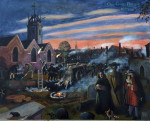
I normally would not take up an issue that is a political hot potato. That’s not what this blog site is about. However, I saw a very interesting article in the BBC entitled DNA Study Finds London was Ethnically Diverse From Start.
If you’ve traveled to London and Paris and walked around a bit, you might have noticed the difference right away: London isn’t an English city any longer, it is an international one. Yet, Paris on the other hand, remains quite French. The BBC article begins by pointing out London was a cosmopolitan town even 2,000 years ago.
It seems there are more than 20,000 human remains (each in their own cardboard box) located at the Museum of London. These remains are former residents of London dating back almost 5,500 years. Scientists and researchers are using new DNA and chemical processes to analyze, among other things, the origins of these folks (why they don’t just go to Ancestry.com I’ll never know). Read More London Immigration

